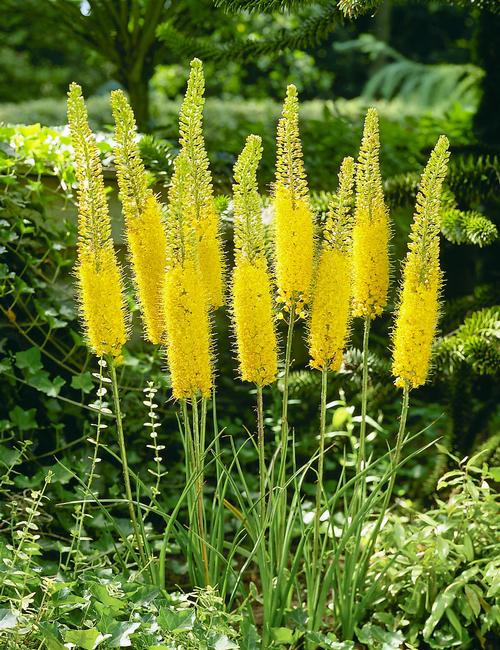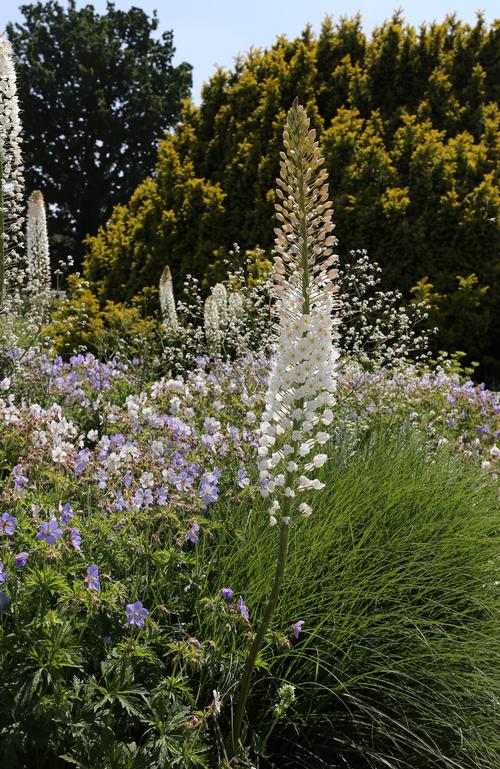Your Guide to Planning, Planting, and Growing Eremurus
Eremurus are known for their fuzzy, bottle brush flowers that bloom from late spring through early summer. The flowers tower over other plants, and can reach heights of 5-6 feet. They open from the bottom up and are available in colors ranging from white and pink to yellow and orange. These impressive, early summer perennials, also known as foxtail lilies or desert candles, add excitement to any flower garden.
What to Know About Eremurus
Eremurus are native to the arid grasslands of Afghanistan and Iran. They are relatively cold tolerant if grown in very well-drained soil. Most varieties are winter hardy in zones 6-11.
These clump-forming perennials may have leaves that are grasslike or strappy. The foliage emerges in early spring and is sensitive to frost. If necessary, protect the foliage with horticultural fabric. In cool climates, plant eremurus in a sheltered location.
After flowering, it's normal for the leaves to die back. The plant will be dormant until it reemerges the following spring. During summer, fall and winter, eremurus should be in soil that stays relatively dry, rather than consistently moist.

How to Plant Eremurus
Plant eremurus in fertile soil with excellent drainage. When preparing the planting area, add organic matter to lighten the soil and if possible, raise the soil level to improve drainage. A sandy loam is ideal.
Choose a warm location where the plants will get full sun and the tall flowers will be protected from strong winds. Keep in mind that the roots of eremurus are shallow and they don't like being crowded or forced to compete with neighboring plants. Once midsummer arrives and the eremurus are dormant, it’s fine for other perennials to overshadow them.

Eremurus roots resemble starfish. They have a prominent crown encircled by long, fleshy roots. Handle the roots gently and plant as soon as possible. Don’t be concerned if the roots appear spongy and discolored, but if they are completely dry it’s unlikely they will grow.
Dig a 6-8” deep planting hole that is wider than the roots. Make a mound of sand in the middle of the hole and center the roots on top of the sand. Then refill the hole. It’s important not to plant the bulbs too deeply. The crown (where roots meet stem) should only be an inch or two below the soil level.
Space the eremurus roots 1 to 3 feet apart, depending on the ultimate size of the cultivar. After planting, mark the location of the plants so you don’t accidentally step on them.

How to Care for Eremurus
In windy areas, and for cultivars that grow extremely tall, eremurus flowers may require staking. When bloom time is over, you can cut the stems back to the base of the plant. If you want the plants to self-sow, allow the spent flowers to stay on until they drop their seeds. As with other flowering bulbs, you should always wait until the foliage has completely yellowed before removing it.
Though eremurus dislike wet soil, they need consistent moisture in the spring when the plants are in active growth. This is also the best time to fertilize them, using a high potassium fertilizer.
If your eremurus become crowded and need to be divided, do it in late summer or early fall. Go slowly, taking extra care not to damage the brittle roots. Gently tease the crowns apart and replant them so the crown is only an inch or two below the soil surface.
In wet winters, eremurus are at risk of being damaged by waterlogged soil. Assist them by clearing debris away from the soil surface and keeping mulch away from the crown of the plant.

